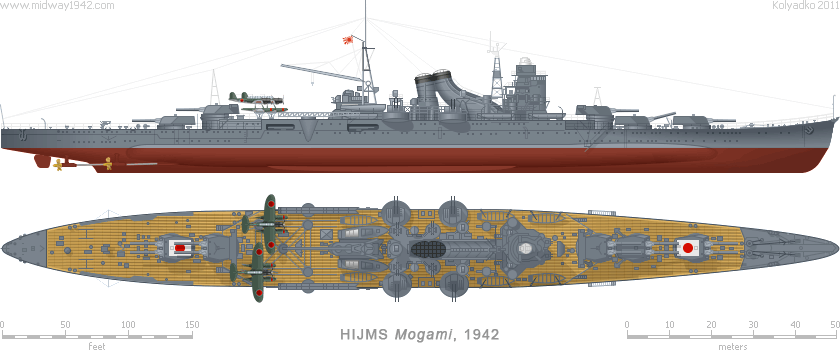
| Mogami class, 最上型 | HEAVY CRUISERS, 重巡洋艦 | |

| Displacement: | 13,440 t (11,169 t Std) | Machinery: | 8-10 boilers*, 4 shafts | Main Guns: | 5×2×8 in (203 mm)/60 | Main Belt: | 3.9 in | 100 mm | |||||||||
|---|---|---|---|---|---|---|---|---|---|---|---|---|---|---|---|---|---|
| Max Length: | 661 ft 5 in | 201.6 m | Max Power: | 152,000 hp | 111 796 kW | DP Guns: | 4×2×5 in (127 mm)/40 | Decks: | 1.4 in | 35 mm | |||||||
| Beam: | 67 ft 7 in | 20.6 m | Max Speed: | 35 kts | 64.82 km/h | AA Guns: | 4×2×0.98 in (25 mm) ** | Barbettes: | 0.98 in | 25 mm | |||||||
| Draght: | 18 ft 1 in | 5.5 m | Range: | 7,500 nm | 13 890 km | Torpedoes: | 4×3×24 in (610 mm) tubes | Turrets: | 0.98 in | 25 mm | |||||||
| Complement: | 896 officers & enlisted | Bunkerage: | 2215-2302 t fuel oil | Air Group: | 2× E13A1 Type 0 ** | Bridge: | 3.9 in | 100 mm | |||||||||
* Mogami, Mikuma - 10 boilers, Suzuya, Kumano - 8 boilers. ** Antiaircraft armament and Air Group as during the Battle of Midway (June 1942).
Four Mogami class cruisers were laid down between 1931 and 1934 as light cruisers to avoid the limitations of the London Naval Treaty, but the barbettes for the main battery were designed for quick refitting with heavier weaponry, and, in actual size, the ships were larger than most heavy cruisers of the day. After a brief period under the categorization as light cruisers, all four ships were equipped with ten 8 in (203 mm) guns in tween turrets replaced previous fifteen 155 mm guns in triple turrets, and re-categorized as heavy cruisers in 1939−1940.
During the war, Mogami class heavy cruisers covered the invasion of Malaya, Java, Borneo, Sumatra, and the Andaman Islands. The ships took part in the Battle of Sunda Strait, the Indian Ocean Raids, the Solomon Islands operations, the Battle of the Philippine Sea, the Battle of Leyte Gulf, and the Battle of the Surigao Strait.
All four Mogami class cruisers took part in the Battle of Midway as a Cruiser Division 7, the core of Close Support Group. A collision between Mikuma and Mogami resulted in both cruisers being caught and bombed by US aircraft on 5 and 6 June 1942. Mikuma was hit by at least four bombs and resulting fires igniting the torpedoes which blew away the rear funnel and mainmast. The ship sank during the night, and Mogami, hit by five bombs, barely escaped to be rebuilt as a floatplane cruiser.
| Ship | Builder | Laid Down | Launched | Commisioned | Fate | |||||||||||||
|---|---|---|---|---|---|---|---|---|---|---|---|---|---|---|---|---|---|---|
| CA-13 最上 | Mogami | Kure Naval Arsenal | 27 | Oct | 1931 | 14 | Mar | 1934 | 28 | Jul | 1935 | Sunk in action | 25 | Oct | 1944 | |||
| CA-14 三隈 | Mikuma | Mitsubishi Shipyards, Nagasaki | 24 | Dec | 1931 | 31 | May | 1934 | 29 | Aug | 1935 | Sunk in action | 6 | Jun | 1942 | |||
| CA-15 鈴谷 | Suzuya | Yokosuka Naval Arsenal | 11 | Dec | 1933 | 20 | Nov | 1934 | 31 | Oct | 1937 | Sunk in action | 25 | Oct | 1944 | |||
| CA-16 熊野 | Kumano | Kawasaki Shipyards, Kōbe | 6 | Apr | 1934 | 15 | Oct | 1936 | 31 | Oct | 1937 | Sunk in action | 25 | Nov | 1944 | |||